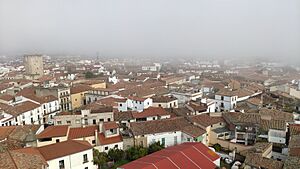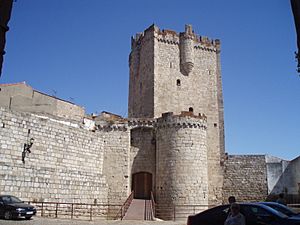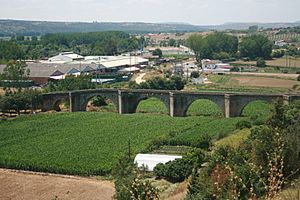Coria, Cáceres facts for kids
Quick facts for kids
Coria
|
||
|---|---|---|
|
Municipality
|
||

View of Coria
|
||
|
||
| Country | Spain | |
| Autonomous community | Extremadura | |
| Province | Cáceres | |
| Area | ||
| • Total | 103.46 km2 (39.95 sq mi) | |
| Elevation | 280 m (920 ft) | |
| Population
(2018)
|
||
| • Total | 12,531 | |
| • Density | 121.119/km2 (313.697/sq mi) | |
| Demonym(s) | Caurienses or Corianos | |
| Time zone | UTC+1 (CET) | |
| • Summer (DST) | UTC+2 (CEST) | |
Coria is a town in Spain. It belongs to the province of Cáceres in the Extremadura region. Besides the main town, it also includes two smaller settlements: Puebla de Argeme and Rincón del Obispo. With about 12,531 people, Coria is the fourth largest town in its province.
It is located right on the bank of the Alagón River. Coria has many old buildings and holds a famous festival each year. This festival is in honor of San Juan and attracts visitors from all over the country.
Contents
History of Coria
Coria has a very long history. It was founded even before the Romans came to the Iberian Peninsula (the land where Spain is today).
Ancient Times
The town was first called Caura. When the Romans arrived, they renamed it Caurium. Later, the city was given Roman citizenship. This meant its people had the same rights as Roman citizens.
After the Romans, the Visigoths took over. During their rule, Coria became very important. It was the center of a diocese, which is an area managed by a bishop in the Christian church. Being the capital of the diocese brought a lot of wealth and growth to the city.
Medieval Period
In the 9th century, Ordoño I, a king from the north, attacked Coria. He took many things and also brought back Christian people called Mozarabs to his kingdom.
During the time of Muslim rule, Coria was a border town. It was not the biggest city, but it was very important for its location. It sat between two major rivers, the Tagus and the Sistema Central mountains. People in Coria mostly farmed, growing crops. There were also many small farming villages, called alquerías, around the main town.
Christian armies fought to take Coria back. They briefly held it in 1077. Then, in 1109, the Almoravids (a Muslim group) took it. Christians tried to capture it again in 1138 but failed. Finally, after a two-month siege in 1142, Christian forces succeeded. The diocese was then brought back to Coria.
In 1174, an Almohad general named Abu Hafs captured the town. But by 1184, Coria was back under Christian control. By the early 1200s, Coria likely had its own special laws, called a fuero. The first clear record of these laws is from 1227. They were probably similar to the laws of Ciudad Rodrigo.
Coria later became the main town of a lordship. This was an area ruled by a lord. Some nearby towns, like Guijo de Coria and Casillas de Coria, are still named after Coria because of this.
Later Conflicts
From 1640 to 1668, there was a war between Spain and Portugal. Coria and its surrounding areas suffered a lot. Even though the Portuguese did not capture the city itself, they often raided the countryside. This made the region much poorer.
Coria's Climate
Coria has a Mediterranean climate. This means it has mild, wet winters and very hot, dry summers.
During summer, temperatures often go above 35 degrees Celsius (95 degrees Fahrenheit). Sometimes, during heat waves, they can even reach over 40 degrees Celsius (104 degrees Fahrenheit)! In winter, temperatures rarely drop below 0 degrees Celsius (32 degrees Fahrenheit). Most of the rain falls in autumn and winter.
| Climate data for Coria 1991-2020 normals | |||||||||||||
|---|---|---|---|---|---|---|---|---|---|---|---|---|---|
| Month | Jan | Feb | Mar | Apr | May | Jun | Jul | Aug | Sep | Oct | Nov | Dec | Year |
| Mean daily maximum °C (°F) | 12.3 (54.1) |
14.4 (57.9) |
18.0 (64.4) |
20.5 (68.9) |
25.4 (77.7) |
30.9 (87.6) |
35.1 (95.2) |
34.9 (94.8) |
29.8 (85.6) |
22.6 (72.7) |
16.0 (60.8) |
12.6 (54.7) |
22.7 (72.9) |
| Daily mean °C (°F) | 7.7 (45.9) |
9.2 (48.6) |
12.3 (54.1) |
14.6 (58.3) |
18.8 (65.8) |
23.6 (74.5) |
27.0 (80.6) |
26.9 (80.4) |
22.8 (73.0) |
17.1 (62.8) |
11.6 (52.9) |
8.5 (47.3) |
16.7 (62.0) |
| Mean daily minimum °C (°F) | 3.1 (37.6) |
4.0 (39.2) |
6.5 (43.7) |
8.6 (47.5) |
12.1 (53.8) |
16.2 (61.2) |
18.9 (66.0) |
18.9 (66.0) |
15.7 (60.3) |
11.7 (53.1) |
7.0 (44.6) |
4.3 (39.7) |
10.6 (51.1) |
| Average rainfall mm (inches) | 45.3 (1.78) |
44.2 (1.74) |
56.4 (2.22) |
47.2 (1.86) |
33.8 (1.33) |
8.4 (0.33) |
3.0 (0.12) |
5.4 (0.21) |
25.6 (1.01) |
82.6 (3.25) |
72.2 (2.84) |
69.0 (2.72) |
493.1 (19.41) |
| Source: Agencia Estatal de Meteorologia (AEMET OpenData) | |||||||||||||
Places to See in Coria
Coria has many interesting historical buildings and sights to visit:
- Roman walls (built in the 3rd-4th centuries AD): These ancient walls show how important Coria was to the Romans.
- Cathedral of Santa María de la Asunción: This large church is built in a style that mixes Gothic elements.
- Bishop's palace (built in 1628): This was the home of the bishop of Coria.
- Castle of Coria (built between 1472–1478): A strong castle that protected the town.
- Baroque Hermitage of Nuestra Señora de Argeme (17th century): A beautiful small church.
- Royal Prisons (built in 1686): An old prison building.
- Old Bridge (Puente Viejo) (from the 15th-16th centuries): An old bridge, though the river has changed its course and no longer flows under it.
- Convent of the Madre de Dios (founded in the 13th century): A convent with parts dating from the 14th to 16th centuries.
- Church of Santiago (16th-18th centuries): A church built in the Baroque style.
- Palaces of the Dukes of Alba (15th-16th centuries): Grand homes that belonged to important noble families.
See also
 In Spanish: Coria para niños
In Spanish: Coria para niños








